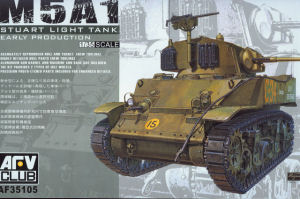
By Kurt Laughlin
Editor's
Note: Kurt Laughlin is the author of A
Field Guide to the M5 Series Light Tanks and the M8 Howitzer Motor
Carriage, available through Formations.
The book provides a written and visual narrative of production changes
through the lifespan of these vehicles. He also provides the range
of registration numbers associated with the vehicles' serial numbers
and production features.
I picked up
this kit at the 2008 AMPS show and since I've done a little reading
on the subject I was asked to review it with regard to detailing
and accuracy. Because my reference is organized to sort of go top
down, that's how I look at the parts.
- The turret
is acceptable for an M5A1, except for the roof. AFV Club has used
their M3A3 roof, which is different in details from that on the
M5A1 (see below). Namely: The M5A1 did not have rivets on the
front of the roof to hold the internal gun travel lock; the holder
for the spotlight weather cap should be behind the spotlight base;
the grabirons in front of the gunner's hatch and the padlock hasp
are in different locations. The roof top antenna mount is included
but there were many M5A1s made without it. Consider removing the
antenna mount, the spotlight base (leave the circular hatch, which
was the original antenna mount location), and the weather cap
holder.
- The engine
deck is the correct four-piece type, with the later simplified
filler cap splash guards. Four-piece decks with complex splash
guards exist and the transition date to the simplified splash
guards is unknown, so the accuracy of the configuration cannot
be determined. Consider backdating the splash guards.
- The hull
looks to be accurate in shape and size, but the weld texture is
a little overdone. The right rear hull antenna port has a splash
ring around it, which seems to be a later production detail. Consider
removing it.
- The glacis
and engine deck configurations are correct for an M5A1.
- The clip
type track stowage is appropriate for an M5A1.
- No air deflectors
or sandshields are included which is okay for an early M5A1. The
front fenders have sandshield attaching screws though, which should
be removed.
- The kit has
a towing pintle, which was not added in production until after
the later turret type entered production. It looks like it can
be omitted easily.
- The suspension
has open spoke bogie wheels, 13- or 14-tooth sprockets, and open
spoke all-metal or plated-over rubber tire idlers. Plating the
wheel openings came after production of the early M5A1 had ended.
A rubber-tired, open spoke idler wheel would be a better choice.
The sprocket should be the 13-tooth variety. The idler bracket
(without skid) is right.
 In
summary, this is a good representation of an M5A1 so long as you
correct a few details. In
summary, this is a good representation of an M5A1 so long as you
correct a few details.
So what vintage
M5A1 can be made from the AFV Club kit? If we look at the introduction
dates of various features we can bracket the build date and serial
numbers. If you want to go with the spoked, all-steel idler you
can model S/N 1471-1985 and 3519-3536 as built, or 533 tanks manufactured.
There were 3576 M5A1s made with the early turret, so you can model
15% of those produced. If you can find a spoked, rubber tire idler
and air deflectors, and include the Formations disc wheel set, you
could cover almost all of the early turret tanks.
Editor's
Note: See also Cookie Sewell's review
and Martin
Dogger's Observations on Building the AFV Club M5A1.
On page 6, replace:
"The M8 began production after the five segment plate was introduced
and kept it throughout its run. Because the M8 didn’t have
a hull machine gun, the casting on the right side of the glacis
was the same size as that on the left."
with:
"The M8 began production after the five segment plate was introduced
and kept it throughout its run. Because the M8 didn’t have
a hull machine gun there was no casting on the right side."
On page 45, replace the upper illustration with this:
|
















 In
summary, this is a good representation of an M5A1 so long as you
correct a few details.
In
summary, this is a good representation of an M5A1 so long as you
correct a few details. 